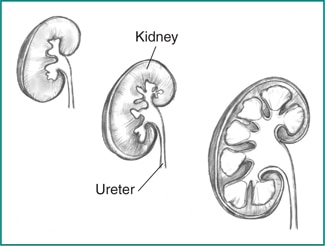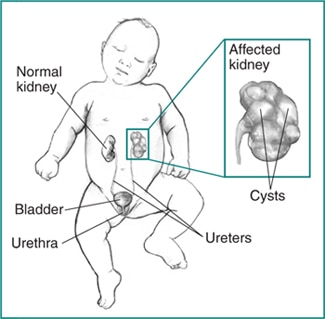How Does an Unborn Baby Get a Kidney Cyst
What is kidney dysplasia?
Kidney dysplasia is a condition in which the internal structures of one or both of a fetus' kidneys practice non develop ordinarily while in the womb. During normal development, two thin tubes of muscle called ureters grow into the kidneys and branch out to form a network of tiny structures called tubules. The tubules collect urine as the fetus grows in the womb. In kidney dysplasia, the tubules neglect to branch out completely. Urine that would normally flow through the tubules has nowhere to get. Urine collects inside the afflicted kidney and forms fluid-filled sacs called cysts. The cysts replace normal kidney tissue and prevent the kidney from functioning.
Kidney dysplasia tin can touch on 1 kidney or both kidneys. Babies with severe kidney dysplasia affecting both kidneys generally do not survive nascency. Those who practice survive may need the post-obit early in life:
- claret-filtering treatments called dialysis
- a kidney transplant
Children with dysplasia in only one kidney take normal kidney function if the other kidney is unaffected. Those with mild dysplasia of both kidneys may not need dialysis or a kidney transplant for several years.
Kidney dysplasia is as well called renal dysplasia or multicystic dysplastic kidney.


What are the kidneys and what do they do?
The kidneys are two bean-shaped organs, each about the size of a fist. They are located just beneath the rib muzzle, one on each side of the spine. Every 24-hour interval, the two kidneys filter about 120 to 150 quarts of blood to produce nearly 1 to 2 quarts of urine, which is composed of wastes and extra fluid. Children produce less urine than adults—the corporeality they produce depends on their age. The urine flows from the kidneys to the bladder through the two ureters, one on each side of the bladder. The bladder stores urine. The muscles of the bladder wall remain relaxed while the bladder fills with urine. As the bladder fills to capacity, signals sent to the brain tell a person to observe a toilet soon. When the bladder empties, urine flows out of the body through a tube chosen the urethra, located at the lesser of the bladder.
What causes kidney dysplasia?
Genetic factors can cause kidney dysplasia. Genes laissez passer information from both parents to the child and determine the kid'southward traits. Sometimes, parents may laissez passer a cistron that has changed, or mutated, causing kidney dysplasia.
Genetic syndromes that bear upon multiple body systems can too cause kidney dysplasia. A syndrome is a group of symptoms or conditions that may seem unrelated withal are thought to accept the aforementioned genetic crusade. A babe with kidney dysplasia due to a genetic syndrome might besides have issues of the digestive tract, nervous organization, centre and claret vessels, muscles and skeleton, or other parts of the urinary tract.
A baby may also develop kidney dysplasia if his or her mother takes certain prescription medications during pregnancy, such equally some used to treat seizures and loftier blood pressure. A mother's apply of illegal drugs, such as cocaine, during pregnancy may besides cause kidney dysplasia in her unborn child.
How common is kidney dysplasia?
Kidney dysplasia is a common condition. Scientists estimate that kidney dysplasia affects about i in 4,000 babies.ane This estimate may be low because some people with kidney dysplasia are never diagnosed with the condition. About half of the babies diagnosed with this condition have other urinary tract defects.ii
Who is more than likely to develop kidney dysplasia?
Babies who are more than likely to develop kidney dysplasia include those
- whose parents have the genetic traits for the condition
- with certain genetic syndromes affecting multiple body systems
- whose mothers used certain prescription medications or illegal drugs during pregnancy
What are the signs of kidney dysplasia?
Many babies with kidney dysplasia in only 1 kidney accept no signs of the condition. In some cases, the affected kidney may exist enlarged at birth and may cause hurting.
What are the complications of kidney dysplasia?
The complications of kidney dysplasia can include
- hydronephrosis of the working kidney. A babe with kidney dysplasia in simply one kidney might have other urinary tract defects. When other defects in the urinary tract block the period of urine, the urine backs up and causes the kidneys and ureters to not bad, a condition chosen hydronephrosis. If left untreated, hydronephrosis can damage the working kidney and reduce its ability to filter blood. Kidney damage may lead to chronic kidney affliction (CKD) and kidney failure.
- a urinary tract infection (UTI). A urine blockage may increase a baby's chance of developing a UTI. Recurring UTIs tin can also lead to kidney harm.
- high claret pressure.
- a slightly increased chance of developing kidney cancer.
How is kidney dysplasia diagnosed?
Health care providers may be able to diagnose kidney dysplasia during a adult female'due south pregnancy using a fetal ultrasound, too chosen a fetal sonogram. Ultrasound uses a device, called a transducer, that bounces safe, painless sound waves off organs to create an image of their structure. Fetal ultrasound is a test done during pregnancy to create images of the fetus in the womb. A specially trained technician performs the procedure in a health care provider'southward office, an outpatient center, or a hospital, and an obstetrician or a radiologist interprets the images. An obstetrician is a md who specializes in pregnancy and childbirth. A radiologist is a medico who specializes in medical imaging. The patient—in this instance, the fetus' mother—does non need anesthesia for this procedure. The images can bear witness defects in the fetus' kidneys and other parts of the urinary tract.
Wellness care providers exercise non always diagnose kidney dysplasia earlier a baby is born. Later on nascence, health care providers often diagnose kidney dysplasia during an evaluation of the child for a UTI or another medical condition. A wellness care provider uses ultrasound to diagnose kidney dysplasia later the infant is born.
How is kidney dysplasia treated?
If the status is limited to one kidney and the baby has no signs of kidney dysplasia, no treatment may exist necessary. Withal, the infant should have regular checkups that include
- checking claret pressure.
- testing blood to measure out kidney role.
- testing urine for albumin, a poly peptide virtually ofttimes found in blood. Albumin in the urine may be a sign of kidney damage.
- performing periodic ultrasounds to monitor the damaged kidney and to make sure the functioning kidney continues to grow and remains healthy.
How can kidney dysplasia exist prevented?
Researchers have not found a way to prevent kidney dysplasia caused by genetic factors or certain genetic syndromes. Pregnant women can prevent kidney dysplasia by avoiding the use of sure prescription medications or illegal drugs during pregnancy. Meaning women should talk with their wellness care provider before taking any medications during pregnancy.
What is the long-term outlook for a child with kidney dysplasia in simply ane kidney?
The long-term outlook for a kid with kidney dysplasia in just one kidney is by and large skilful. A person with ane working kidney, a condition called solitary kidney, tin grow usually and may have few, if any, health problems.
The affected kidney may shrink as the child grows. By age 10,3 the affected kidney may no longer exist visible on x-ray or ultrasound. Children and adults with only 1 working kidney should have regular checkups to test for high blood pressure level and kidney harm. A child with urinary tract issues that pb to failure of the working kidney may somewhen demand dialysis or a kidney transplant.
What is the long-term outlook for a child with kidney dysplasia in both kidneys?
The long-term outlook for a child with kidney dysplasia in both kidneys is different from the long-term outlook for a kid with 1 dysplastic kidney. A child with kidney dysplasia in both kidneys
- is more than likely to develop CKD.
- needs close follow-up with a pediatric nephrologist—a dr. who specializes in caring for children with kidney illness. Children who live in areas that don't take a pediatric nephrologist available tin can meet a nephrologist who cares for both children and adults.
- may eventually demand dialysis or a kidney transplant.
Eating, Diet, and Diet
Researchers take not found that eating, nutrition, and diet play a office in causing or preventing kidney dysplasia.
Clinical Trials
The National Institute of Diabetes and Digestive and Kidney Diseases (NIDDK) and other components of the National Institutes of Health (NIH) bear and support research into many diseases and conditions.
What are clinical trials and what office do children play in research?
Clinical trials are research studies involving people of all ages. Clinical trials expect at new means to prevent, notice, or treat disease. Researchers besides use clinical trials to look at other aspects of care, such as improving quality of life. Enquiry involving children helps scientists
- place care that is best for a child
- find the all-time dose of medicines
- detect treatments for conditions that only affect children
- care for weather condition that behave differently in children
- understand how treatment affects a growing child's body
Find out more about clinical trials and children.
What clinical trials are open?
Clinical trials that are currently open up and are recruiting can be viewed at world wide web.ClinicalTrials.gov.
References
Source: https://www.niddk.nih.gov/health-information/kidney-disease/children/kidney-dysplasia